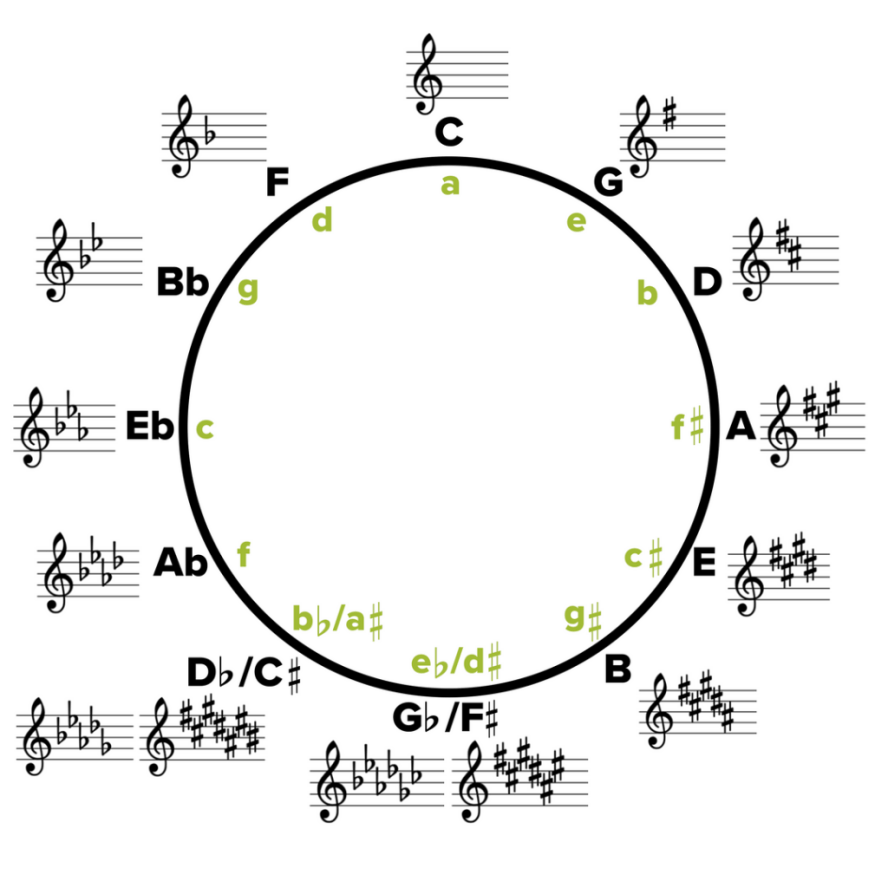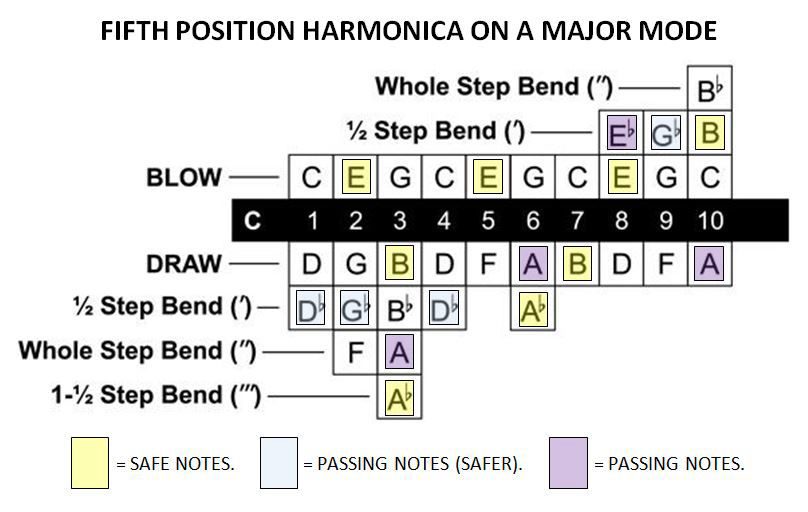
If you are longing to play harmonica in the fifth position; reading this article as well as practising on the harp, as per instructions included within, will enable you soon to perform in one of the best viable positions possible with harmonica. If you are a upper-beginner or intermediate player, the fifth position online course can be the course for you.
Taking a closer look at the circle of fifths reveals that the fifth position is the one which precedes the key of the song by four positions, while scrolling the circle counterclockwise. For example: if we take a C harmonica, we can play in fifth position on a E tune. The same would be true if we take a G harp; i.e. we will then be able to play fifth position B song.

Fifth harmonica position is usually used on minor tunes.
When you are choosing harmonica and the position to play wherein, you must analyze the instrument to figure out which notes are effective in the chosen tonality, which ones are missing, and which notes we must avoid playing at any cost because they aren't part of the tonality. Most often, we assume that same position can be utilized again in variety of musical contexts, since a song can be major, minor, or blues type. In addition to this, we must take into account the quality we expect with its execution, because the notes that are benificial for playing melodic lines, might not prove to be that advantageous in producing chords at the same position. We will address this issue in another lesson.
Let's begin evaluating fifth position on a major song. The answer to the question,"What constitutes a major tune?" would be the third interval of its reference scale. In the case of a C major tune, the third is E. If this note is natural, the song mode will be major, if it is flat, the song mode will be minor. Wondering about, "What about the blues mode then?" Let's say that it comes midway on a continuum between major and minor; owing to the reason that - on the blues - major and minor thirds both can be equally played. The minor third is called 'blue note', and that's what assigns the characteristic feature to the blues musical genre.
Let's go back to the major tonality and the harmonica in fifth position; e.g. we take a C harp and play in fifth position on a E tune.
If the song is in E major, its reference musical scale will have the following notes: E, F#, G#, A#, B, C#, D#.
Not all the notes of this scale are present on a C diatonic harmonica. We may obtain some with the bending technique, whereas other notes can't be played if the technique of overbending isn't used.
There is a hierarchy that exists among the notes of the scale and if we significantly identify it, we will always be able to judge which notes to use and for what reason. One should realize the fact that though, every note has a particular function with respect to the scale of reference, its connection - with respect to the chord presented by the chord sequence of the song - can't be ignored either.
The most important note when playing in fifth position is the same as the one that gives the name to the key; in this case, it's an E. Let us consider this note as grade 1, so that even when we alter the key, the reasoning remains unchanged.
To grab these concepts, I always refer to the notes emitted by C instrument which are then transposed by the harmonica, for us, when we change the key.
The E note is located on the holes 2, 5 and 8 blow. Whenever we play these holes, we'll always be tuned with the song.
The second important note to play in fifth position is the G sharp: the third grade; because as we know it, this is the one which decides the mode of the song. Since we are on a major tune, the harmonica delivers this note on holes 3 with bends of three semitones and on hole 6 with a one half-tone bend.
The third considerable note for the third position is B: the fifth degree, and we'll find it on holes 3 draw, 7 draw, and 10 blow with a half-tone bend.
These are the important notes because they form the E major chord.
We'll move forward to the other notes now:
The F sharp or second interval, sounds delightful anywhere during the E major song, and we find it on hole 2 draw with a half-tone bend and on 9 blown also with a one step bend.
The A note or fourth interval should be used as a passing note because in some contexts - in coherrence with the harmonic progression of the song - it might sound a bit, 'off the theme'. You will find this note on hole 3 draw, bending a whole-tone, and on holes 6 and 10 draw.
The C sharp note or sixth interval can be played at will and has no conflicts. You will find it on holes l and 4 draw with a half-tone bending.
The last note we are going to consider is D#. This note, also called 'sensitive', is a peculiar one and is at its best when used as a passing note. Unfortunately, we only have this note on hole 8 blow with a one step bend.
To make learning, the fifth position with harmonica, easier for you; I have depicted the notes layout of instrument for you, on which 'hierarchy of notes to play' has been highlighted.

From the above mentioned analysis, it is obvious that playing in fifth position on a major tune is not advisable as there are quite some notes which we cannot play.
Let's carry out the same analysis for a minor track; be careful as you're about to find that the fifth position on a minor track is really great!
Along with the minor tunes, there are several reference scales to consider, the important thing however is that the third must be played flat: in the case of E key, the G becomes natural. This is the 'Dorian' minor scale: E, F#, G, A, B, C#, D. If we want to play more 'safe', we will lower a semitone even the grade 6, so that the C sharp becomes a natural C. The new scale reference will become: E, F#, G, A, B, C, D.
It is noticable that these notes, except for the F sharp, are the same of the C major scale, so it can be deduced that with a C harp we can easily play in fifth position on a minor E tune.
That is why, as I have just expressed, this is one of the best positions to play in minor. We'll find the F# on the hole 2 draw, half-tone bend, and on hole 9 blow half-tone bend.
With the fifth position on minor tracks, we can work well using the E minor pentatonic scale which is equivalent to that of G major. Meanwhile we are learning to play in second position, we are basically affirming as if how to play in fifth position also.
Let's analyze harmonica notes to play the blues in fifth position.
The E blues scale consists of the following notes: E, G, A, A#, B, D.
In addition to the notes of the G pentatonic scale, we consider the sharp A as one step bend on hole 3 draw, the same can be found on hole 10 blow, one step bending.
It is said that we can play a full E blues scale on holes l to 5.
I summarize briefly the purpose of the fifth position:
Fifth position harmonica on major tunes: possible yet limited use.
Fifth position harmonica on minor tunes: strongly recommended.
Fifth position harmonica on blues: though possible but does not yield the best output.
I invite you to explore other positions with the harmonica so as to learn how to wisely select a peculiar position, and adopt it during performance. See you soon!
Michael Downson
This is great! I always use 3rd position for minor playing, but I'm going to give this a try! Sounds interesting and effective.
Marcus De luca
Thank you for this great explanation. I will practice 5th position and see if I can play better on the minor tunes my band has in the repertoire. Good job!
Willy Costa
I still have to learn to play single notes on harmonica, but I will try to apply what you're teaching here cause I love minor songs.